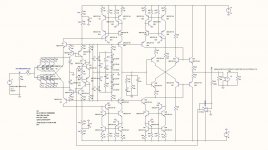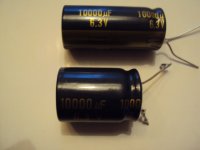Not 'pop'- but 'avalanche'-noise
Some information con be found here: Random Electrical Noise: A Literature Survey
There is some thruth in it, at that voltage its pretty far away from the breakdown voltages.
I researched this thoroughly about 3 years back, and posted some information here, just havent found it yet.
The lowest noise comes from tempco zeners and why 1n829 is one of the quitest zeners money can buy, they cost around 8 to 9 euros.
Ill try get the info I got over the weekend and post it.
There is some thruth in it, at that voltage its pretty far away from the breakdown voltages.
I researched this thoroughly about 3 years back, and posted some information here, just havent found it yet.
The lowest noise comes from tempco zeners and why 1n829 is one of the quitest zeners money can buy, they cost around 8 to 9 euros.
Ill try get the info I got over the weekend and post it.
I have found one supplier that sells them at ~half euro/1pc. At the moment he has 150 in stock. Production of Microsemi. I can make a phone call this Monday to confirm web-page status.
Will add that...and post new schematic later toady.... to be clear I suppose you mean R27 and R 29.. True that takes even more noise out, and reduces the resistor current noise at the same time.. good thinking..! (again)
The C-3-4-8-9 is supposed to be 10mF and 3.3 Uf for decoupling, though the decoupling is not needed on a high impedance current mirror, I can still hear it, and if at Mundorf tinfoil cap is used it add's a pleasant calm warmth to the sound. ( just one of those things you can hear, but not explain)
10mF = 10000uF ?
mad-z, that would be good to know. Maybe we find another zener that is quiet and not expensive. If that is the last problem we have, fine.
Yes, the original value was 10.000uF. Now that the bias structure is changed we may not need such a big value any more. Michael will find out whats best.
I find other little things in the last schematic. For example the RIAA components are not connected. I wait for Michaels next version and look more careful on that.
mad-z, that would be good to know. Maybe we find another zener that is quiet and not expensive. If that is the last problem we have, fine.
I will check that on Monday.
Besides above BZX85C and BZX83C were advertised as high stability low noise types.
http://www.vishay.com/docs/85608/85608.pdf
Last edited:
Looks good to me on first sight. Yes, the 10mF have to be. The AC signal is in series with it and the input stage is very low impedance so we form a high pass filter. I use a Panasonic 10.000uF-6,3V usually. I like Panasonic FM a bit better but 6800uF is the biggest value. Hesener, could you make place on the PCB for 2 x 6800uF 6,3V FM parallel in that position ?
For drift it's not so important as the servo will remove that, but for balances in the circuit It could be a good idea to match the mirror pairs...Joachim you have more experience here than I do...
I second the Panasonic FM's as well the Rubycon ZL's which I find sound very clear and organic...
I second the Panasonic FM's as well the Rubycon ZL's which I find sound very clear and organic...
Last edited:
I have not done that on my previous builds, if there was no servo i would say that it was mandatory, but it could never work without a servo, or a Cap before the buffer, as the gain is seriously high, I do believe that anything that can be done to aid thermal tracking should be done, but to say that it would have audible effects is beyond me..
For drift it's not so important as the servo will remove that, but for balances in the circuit It could be a good idea to match the mirror pairs...Joachim you have more experience here than I do...
I second the Panasonic FM's as well the Rubycon ZL's which I find sound very clear and organic...
I have also good results with Rubycon ZA - which are from the same line as ZL's but more compact/lower impedance AFAIR
Plenty of choices anyway...
Some like the Rubicons, some not. I found that they have even lower impedance then FM but not much. But that is not a real problem. As long as we do not go into Elna Silmik 2 or Nichicon KZ Muse, that are both very big in size, we can fit anything you like.
Concerning the thermo coupling in the mirror i never tried that. As what Michael found we need a cap or servo anyway. Hfe matching is an advantage. I think 10% matching is fine.
Fortunately BJts do not go astray as much as Fets and the Hfe of the NPNs and PNPs we chose are very similar.
Concerning the thermo coupling in the mirror i never tried that. As what Michael found we need a cap or servo anyway. Hfe matching is an advantage. I think 10% matching is fine.
Fortunately BJts do not go astray as much as Fets and the Hfe of the NPNs and PNPs we chose are very similar.
I recently made a test for Salas, building his Reflektor shunt and was forced to thermo couple the upper bjt´s on the Wilson improved mirror to avoid Vout drift.
A minor change that made all the difference... that is why I asked... but if the servo takes care of that 🙂
I also prefer FM to ZA or ZL.... these tend to sound thin in some analog applications.... but they produce a sweet trebble.... A matter of taste.
I am planning to build the Paradise p2p so I will test it and report.
What type of resistors can I use ? Is there any particular whattage for any of them ?
A minor change that made all the difference... that is why I asked... but if the servo takes care of that 🙂
I also prefer FM to ZA or ZL.... these tend to sound thin in some analog applications.... but they produce a sweet trebble.... A matter of taste.
I am planning to build the Paradise p2p so I will test it and report.
What type of resistors can I use ? Is there any particular whattage for any of them ?
Last edited:


